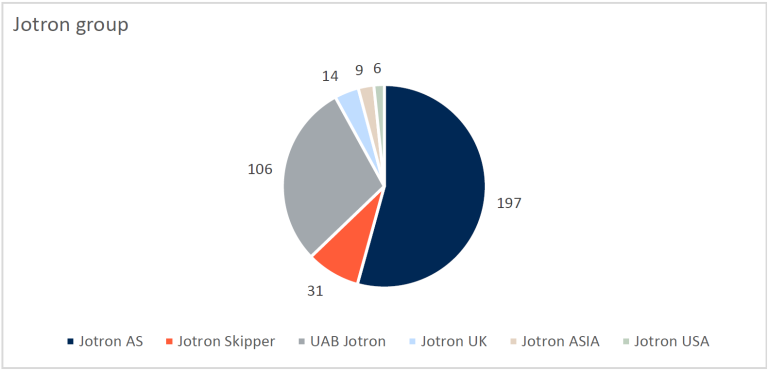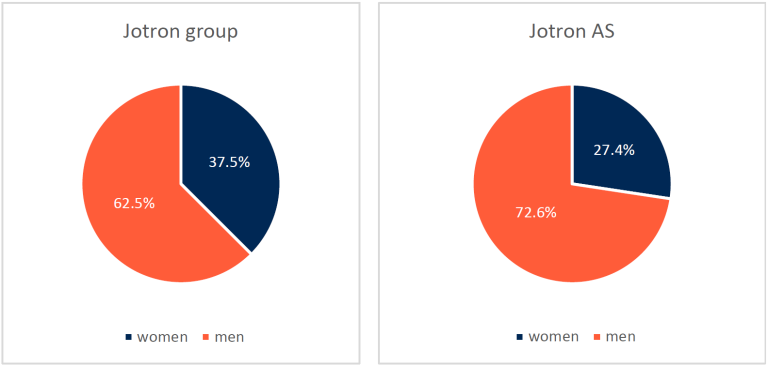Statement of equality and non-discrimination 2024

1. Introduction
Equality means that we facilitate equal opportunities and rights for all employees, regardless of gender, cultural background, ethnicity, disability, life situation, gender identity and expression, religion, or sexual orientation. No one should experience harassment, discrimination, or restricted, freedom based on who they are, and everyone should have the right to be themselves. Jotron consists of a diverse group of people, which makes us better equipped to develop products, solutions, and services that our customers and society need.
2. State of gender equality
At the end of 2024, the Jotron Group had a total of 363 employees, comprising 227 men and 136 women. Within Jotron AS, the parent company based in Norway, there were 197 employees, with 143 men and 54 women. This indicates that men remain in the majority in terms of gender distribution.


2.1 Women in leadership and board positions
Jotron has actively worked to increase the proportion of women in leadership positions and governing bodies. As of the end of 2024, the gender balance is as follows:
- The corporate management team consists of 7 women and 10 men.
- The company's managing director is a woman.
- The board has a slight majority of women, comprising 4 women and 3 men.
2.2 Types of employment
Jotron advertises nearly all full-time positions. In 2024, the employment types at Jotron were as follows:
- Part-time employees: 6 people (4 men, 2 women), all by their own choice.
- Temporary employees: 11 people (9 men, 2 women), of which 7 are in education (apprentices or students).
2.3 Parental leave
In 2024, the parental leave metrics at Jotron were as follows:
- 5 men and 3 women took parental leave in 2024.
- Average number of weeks: 13.98 weeks.
2.4 Sick leave
In 2024, the sick leave metrics at Jotron were as follows:
- Total sick leave in 2024: 4.19% (compared to 2.85% in 2023).
- Women had a slightly higher sick leave rate (+2.04 percentage points compared to men).
2.5 Pay equality
At Jotron, all employees should be properly compensated for the work they perform, regardless of gender. In connection with wage settlements, annual assessments of equal pay are conducted.
The company has a wage system developed in collaboration with the employee representatives. All positions are placed in one of the nine job levels/wage groups defined between levels 10-19. The wage system has defined the requirements for knowledge and skills across the various job levels within the organisation.
Essential for placement in a job level is the job description, where the position's responsibilities, tasks, and competency requirements are mapped and described. A position is graded in relation to three different dimensions: competence, problem-solving, and responsibility.
The table below shows the proportion of women and men (2024 figures) in the various job levels, and the difference in average salary between women and men relative to the average salary of men:
| Level of position/salary | Number of women | Number of men | Pay gap* |
| 10-13 | 21 | 14 | 0.2% |
| 14-17 | 22 | 93 | 1.1% |
| 18-19 | 9 | 28 | 11.9% |
*difference in average salary as a percentage of the average for men
The figure excludes apprentices. Negative percentage indicates higher wages for women. Overall for the company, the average salary difference between women and men is 4.3%.
The 4.3% wage gap in favour of men in our company can be explained by the traditional gender distribution between roles. The company has a predominance of men in engineering roles and a larger proportion of women in administrative roles. Such gender division is common in technically oriented companies. Engineering positions generally have higher average salaries compared to administrative positions, which affects the overall average salary for men and women, respectively. The company analyses wage differences annually to ensure that there are no systematic biases.
3. Our work for equality and against discrimination
Jotron works preventively to avoid discrimination and will actively, purposefully, and systematically work to promote equality and prevent discrimination. In employee surveys as well as ongoing meetings with union representatives and employees, the risk of discrimination or other obstacles to equality is discussed.
In 2024, an evidence-based survey on equal opportunities and inclusion was conducted at Jotron. The survey included 153 employees, corresponding to an 82 percent participation rate. The survey consisted of six questions related to six different aspects of equal opportunities and inclusion.
The survey results show that Jotron generally scores high on inclusion and diversity, with particularly strong results for accommodation of employees with different religions, ethnicities, or cultural backgrounds (4.56) and accommodation of employees with different sexual orientations or gender identities (4.33). The lowest score is for accommodation of employees with various illnesses or disabilities (4.09), but this is still a positive score.
Jotron has the following overall objectives for the period 2024-2026:
- Developing a clear strategy for diversity and inclusion
- Increasing gender balance at all levels of the organisation
- Enhancing diversity through recruitment
- Improving competence on diversity management at all leadership levels in the organisation
3.1 Developing a clear strategy for diversity and inclusion
Thoroughly assess the current state of diversity and inclusion in the company and identify areas that need improvement. Then, develop a vision statement that clearly communicates the company's commitment to diversity and inclusion.
3.2 Increasing gender balance at all levels of the organisation
Primarily, the lack of gender equality in the workplace is a barrier for women, although men can also be affected. Historically, the technology industry has had a large predominance of men, especially in development and engineering, and this pattern is also seen at Jotron. Jotron's focus area is to strive for gender-neutral advertisements in recruitment processes. This is to encourage particularly women, but also men, to apply for jobs based on their interests and qualifications, without being limited by traditional stereotypes. The company also works to highlight female employees in engineering and development positions through external and internal channels. Over the past three years, Jotron has collaborated with schools and universities to inspire more girls, but also boys, to choose technology subjects.
3.3 Enhancing diversity through recruitment
This is done to reflect the diversity among our employees and to attract a broader group of candidates with different backgrounds. By encouraging underrepresented groups to apply for positions with us, we also state in all job advertisements that we desire greater diversity. For each recruitment project, we will therefore invite at least one person from an underrepresented group for an interview. To support the integration and inclusion of employees with different backgrounds, the company offers language courses and the opportunity to participate in a cultural group where employees can learn more about Norwegian society and working life.
3.4 Improving competence on diversity management
Managing diversity can be a challenging task for leaders, as it often requires significant time and effort. Language barriers, professional differences, and cultural disparities can pose potential obstacles that demand considerable attention. The company will implement leadership development programs focused on diversity and inclusion to enhance leadership engagement and ensure that management actively supports and participates in diversity initiatives. This will be achieved by raising awareness and understanding of why increased diversity is necessary and how it can be best managed. Jotron has placed diversity on the agenda in various leadership meetings and in the Working Environment Committee (AMU).
